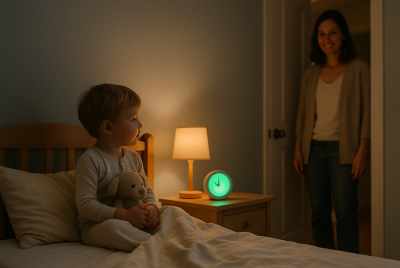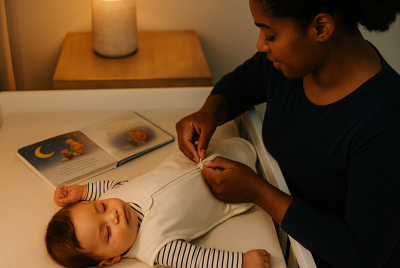Baby Swaddle Blankets: Everything You Need to Know
We may earn a commission for purchases made using our links. Please see our disclosure to learn more.
Having a newborn can be an absolute whirlwind, right? One moment you’re adjusting to this tiny, brand-new human in your life, and the next, you’re caught up in a dozen different things people say you should be doing—one of those being swaddling. Swaddling isn’t some new trend; it’s actually a tried-and-true technique that’s been around for centuries. And the modern-day hero of this art? Baby swaddle blankets. Let’s dive into everything you need to know to make sense of these blankets, get some tips on using them, and help you (and baby) enjoy a good night’s sleep.
What’s the Deal with Baby Swaddle Blankets?
Swaddle blankets are basically soft, square blankets designed to wrap around your baby snugly. If you’ve ever wrapped up in a cozy, oversized sweater, you get the idea. Swaddling helps babies feel secure, cozy, and a bit like they’re back in the womb (which they loved, by the way).
Why Even Swaddle Your Baby?
So, what’s the big fuss about swaddling? Well, if you’ve noticed how babies tend to jerk awake with sudden arm movements (called the Moro reflex), swaddling is your best friend. It helps calm these reflexes, giving your little one a better chance of sleeping soundly. And let’s be honest—if the baby sleeps well, everyone wins.
Real Benefits of Swaddling
Swaddling does a lot more than just keeping babies cozy:
- Better Sleep for Baby and You: Swaddling can help calm that startle reflex, which means fewer wake-ups.
- Less Fussing, More Cuddling: Babies tend to feel secure and calm when swaddled, cutting down on those 3 a.m. freak-outs.
- Good Sleep = Happy Brain: Good rest is vital for your baby’s brain development, so swaddling helps them (and you!) feel better rested.
- Easier to Handle: Swaddling makes babies feel more contained, which can help if your little one is extra wiggly.
Different Kinds of Swaddle Blankets
There are a bunch of different swaddle blankets out there. It’s easy to get a bit lost, so here’s the lowdown:
- Classic Swaddle Blankets: These are the simple, square blankets you wrap manually. They’re flexible, but you need a good wrapping technique.
- Swaddle Sacks: These are like little bags with zippers or Velcro that make swaddling a snap (especially handy at 2 a.m. when your brain is barely functioning).
- Swaddle Pods: Imagine a tiny cocoon for your baby. These stretchy little sacks are a fuss-free option for snug wrapping.
- Sleep Swaddles: These blankets have flaps to swaddle and can transition into sleep sacks as your baby grows.
Finding the Right Swaddle Blanket
When shopping for swaddle blankets, focus on materials, size, and closure types. Light, breathable fabrics work best, especially if you’re somewhere warm. Closure type matters too—Velcro, zippers, or just classic blankets—pick what feels easiest for you (and won’t drive you nuts in the middle of the night).
Fabrics and Materials in Swaddle Blankets
The material is a big deal, not just for comfort but for safety. Let’s break down the popular options:
- Cotton Muslin: It’s breathable, lightweight, and perfect for hot weather.
- Organic Cotton: Good for sensitive skin, free from chemicals, and eco-friendly.
- Fleece: Warm and cozy, great for winter, but watch out for overheating.
- Bamboo: Super soft and naturally hypoallergenic, ideal for babies with sensitive skin.
Getting the Right Size Swaddle Blanket
Swaddle blankets typically come in standard sizes, like 40 x 40 inches or 48 x 48 inches. These sizes are big enough to wrap around your baby snugly but not so huge that you feel like you’re wrestling with a bedsheet. For the tiniest newborns, though, consider smaller or fitted swaddle sacks.
When to Start and Stop Swaddling
Swaddling can start right from birth (actually, many hospitals do it for you!). Most parents swaddle for the first 2-4 months, but as soon as your baby starts rolling over, it’s time to transition to something that allows more arm movement.
How to Swaddle: A Quick Guide
Here’s a quick, easy method to swaddle your baby:
- Lay Out the Blanket: Spread out the blanket on a flat surface and fold down one corner.
- Position the Baby: Place the baby face-up with their neck at the fold.
- Wrap the Right Side: Take the right corner of the blanket and wrap it across the baby’s body, tucking it under their left arm.
- Bring Up the Bottom: Pull the bottom of the blanket up and over the baby’s feet.
- Wrap the Left Side: Pull the left side across and tuck it underneath.
Swaddling Tips for Different Baby Stages
For newborns, a snug wrap is best. But as babies grow, they might want their arms free (some blankets let you do an arms-out swaddle, which is awesome for older babies).
How to Swaddle Safely
Safety is huge when swaddling:
- Don’t Swaddle Too Tight: Leave some space around the hips to avoid hip dysplasia.
- Lay Baby on Their Back: Always, always place them on their back for sleep to reduce the risk of SIDS.
- Avoid Overheating: Use breathable materials and don’t add extra layers.
Swaddling vs. Sleep Sacks (Yes, There’s a Difference)
Swaddling wraps your baby snugly, while sleep sacks are looser and more like wearable blankets. Swaddles are great for the newborn phase, but as soon as they start moving around more, a sleep sack is often the safer, easier choice.
Are All Babies Okay with Swaddling?
Honestly? Some babies just don’t love it. They’re all different, after all. (One of my friends has a baby who loves having his arms free—little Houdini!) If your baby seems uncomfortable, don’t stress; try adjusting or move on to sleep sacks.
Swaddling Mistakes (We’ve All Been There)
Everyone makes mistakes, especially with all the conflicting advice out there. Here are the top three things to watch out for:
- Swaddling Too Loose or Tight: A loose swaddle can come undone, while a tight swaddle can make it hard for baby to breathe comfortably.
- Straightening the Legs: Tight leg wrapping can lead to hip issues, so always leave room for their legs to bend a bit.
- Over-Swaddling: Babies can overheat easily, so keep it light, especially in warm weather.
Caring for Your Swaddle Blankets
Swaddle blankets get used a lot, and they’re constantly in contact with your baby’s skin. Wash them often, use a mild detergent, and skip the fabric softener (it can irritate sensitive skin).
Top Swaddling Myths Busted
- “Swaddling Is Dangerous for Babies” – Not when done correctly; it’s safe and beneficial.
- “All Babies Love Swaddling” – Some do, some don’t.
- “You Can Swaddle as Long as You Want” – It’s best to stop around 2-4 months or once they’re rolling over.
- “Swaddling Causes Hip Problems” – Only if done too tight around the legs.
- “Swaddled Babies Sleep All Night” – It can help, but no guarantees here, folks!
Scientific Research on Baby Swaddling: Key Findings and Safety Insights
“Swaddling: A Systematic Review” (2007)
This comprehensive review evaluated the benefits and risks of swaddling. It found that swaddling can increase sleep duration and reduce crying in infants. However, the review also highlighted potential risks, such as an increased likelihood of hip dysplasia if swaddling is done improperly, and a possible association with sudden infant death syndrome (SIDS) when infants are placed in a prone position while swaddled.
“Swaddling and the Risk of Sudden Infant Death Syndrome: A Meta-analysis” (2016)
This meta-analysis examined the relationship between swaddling and SIDS. The study concluded that swaddling is associated with an increased risk of SIDS, particularly when infants are placed on their stomachs or sides to sleep. The risk also appeared to increase with the infant’s age.
“Influence of Swaddling on Sleep and Arousal Characteristics of Healthy Infants” (2005)
This study investigated how swaddling affects infants’ sleep patterns and arousal thresholds. The findings indicated that swaddling increases the duration of quiet sleep and decreases spontaneous arousals, suggesting that swaddled infants may sleep more soundly.
“The Effect of Swaddling on Infant Sleep and Arousal: A Systematic Review” (2022)
This recent review analyzed studies on swaddling’s impact on infant sleep and arousal. It concluded that swaddling is associated with increased quiet sleep duration and reduced sleep state changes, particularly in infants not previously accustomed to swaddling. However, the review emphasized the importance of proper swaddling techniques to mitigate potential risks.
Related Products Available on Amazon
For parents interested in swaddling, several products on Amazon can assist in providing comfort and safety for your baby. Here are some notable options:
- Love to Dream Swaddle UP: Designed to let babies sleep in their natural “arms up” position, this swaddle promotes self-soothing and restful sleep.
- aden + anais Essentials Muslin Swaddle Blankets: Made from soft, breathable muslin, these versatile blankets can be used for swaddling, as a stroller cover, or a nursing cover.
- SwaddleMe Original Swaddle: Featuring adjustable wings with hook-and-loop closures, this swaddle ensures a snug fit to prevent the startle reflex.
- Miracle Blanket Swaddle: Known for its unique design, the Miracle Blanket securely swaddles without the use of Velcro or zippers, reducing the risk of unraveling.
These products offer various features to accommodate different swaddling preferences and needs, aiming to provide a safe and comfortable sleeping environment for your baby.
Summary
Swaddling can be a lifesaver, helping your baby sleep better and feel more comfortable. Finding the right swaddle blanket, knowing the basics of how to swaddle, and being aware of safety tips are all important steps. Ultimately, every baby is unique—what works for one might not work for another, so feel free to try different types and techniques until you find what suits you and your little one best.
FAQs
- Is it safe to swaddle my baby overnight? Yes, as long as you follow safe swaddling guidelines, lay your baby on their back, and don’t overheat.
- What’s the best material for swaddle blankets? Cotton muslin and organic cotton are ideal; they’re breathable and gentle on skin.
- When should I stop swaddling? Around 2-4 months or as soon as your baby starts rolling over.
- Can I swaddle my baby with their arms out? Absolutely! Many babies like having their arms out as they get a bit older.
- How can I tell if my baby is too hot while swaddled? Feel the back of their neck. If it’s very warm or sweaty, it might be time to adjust the blanket or take off a layer.
Swaddling might seem like a small thing, but it can make a big difference in helping your baby sleep comfortably. And trust me, more sleep for them means more sleep for you.




